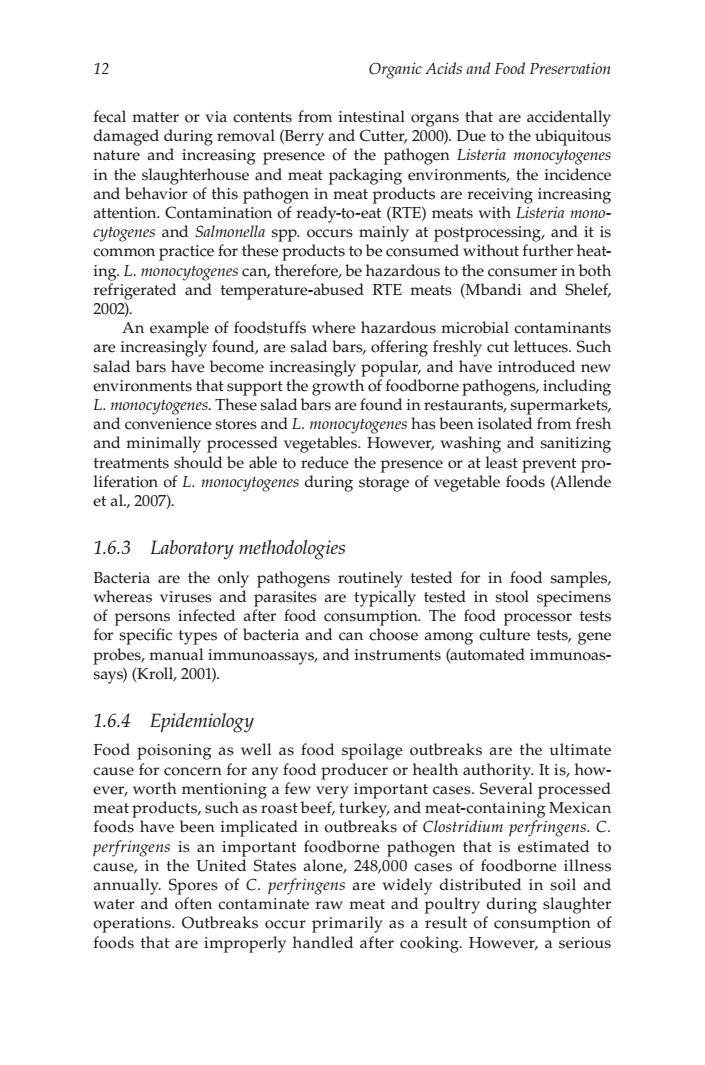正在加载图片...

3 Organic Acids and Food Preservation fecal matter ans that are accidentally damaged ring removal (Berry and Cutter ne to the ubiquitous nature and increasing presence of the pathogen Listeria m in the slaughterhouse and meat packaging environments,the incidence and behavior of this pathogen in meat products are receiving increasing attention.Contamination of ready-to-eat(RTE)meats with Listeria mono- cytogenes and Salmonella spp.occurs mainly at postprocessing,and it is common practice for these roducts to be consumed without further heat- ing.L. togenes can,th e be hazardous to the umer in both erated and temperature-abused RTE meat (Mba d and Shel 200 An example of foodstuffs where hazardous microbial contaminant are increasingly found,are salad bars,offering freshly cut lettuces.Such salad bars have become increasingly popular,and have introduced new environments that support the growth of foodborne pathogens,including L.monocytogenes.These salad bars are found in restaurants,supermarkets, and con ience stores and L.monocutogenes has been isolated from fresh and minimally sed vege etables.However, washin g and sanitizing eatments should be able to reduce the presence or at l pro liferation ofL storage of vegetable foods(Allende etal,2007. 1.6.3 Laboratory methodologies Bacteria are the only pathogens routinely tested for in food samples whereas viruses and arasites are typically tested in stool spe s infected after food umption he food P s of bacteria and an ch noose among cul tests,gene probes,ma anual immunoassays,and instruments(automated immunoas- says)(Kroll,2001). 1.6.4 Epidemiology food poisoning as well as food spoilage outbreaks are the ultimate cause for ern for any food pro ducer or health authority.It is,hov ever,wort ing a t case meat products,such as roas beef,tu rkey,an ontaining Mexica foods have been implicated in outbreaks of Clostridium perfringens.C perfringens is an important foodborne pathogen that is estimated to cause.in the United states alone.248.000 cases of foodborne illness annually.Spores of C.perfringens are widely distributed in soil and water and often contaminate raw meat and poultry during slaughter operations.Outbreaks occur primarily as a result of consumption of dled after cooking.However,a seriou12 Organic Acids and Food Preservation fecal matter or via contents from intestinal organs that are accidentally damaged during removal (Berry and Cutter, 2000). Due to the ubiquitous nature and increasing presence of the pathogen Listeria monocytogenes in the slaughterhouse and meat packaging environments, the incidence and behavior of this pathogen in meat products are receiving increasing attention. Contamination of ready-to-eat (RTE) meats with Listeria monocytogenes and Salmonella spp. occurs mainly at postprocessing, and it is common practice for these products to be consumed without further heating. L. monocytogenes can, therefore, be hazardous to the consumer in both refrigerated and temperature-abused RTE meats (Mbandi and Shelef, 2002). An example of foodstuffs where hazardous microbial contaminants are increasingly found, are salad bars, offering freshly cut lettuces. Such salad bars have become increasingly popular, and have introduced new environments that support the growth of foodborne pathogens, including L. monocytogenes. These salad bars are found in restaurants, supermarkets, and convenience stores and L. monocytogenes has been isolated from fresh and minimally processed vegetables. However, washing and sanitizing treatments should be able to reduce the presence or at least prevent proliferation of L. monocytogenes during storage of vegetable foods (Allende et al., 2007). 1.6.3 Laboratory methodologies Bacteria are the only pathogens routinely tested for in food samples, whereas viruses and parasites are typically tested in stool specimens of persons infected after food consumption. The food processor tests for specific types of bacteria and can choose among culture tests, gene probes, manual immunoassays, and instruments (automated immunoassays) (Kroll, 2001). 1.6.4 Epidemiology Food poisoning as well as food spoilage outbreaks are the ultimate cause for concern for any food producer or health authority. It is, however, worth mentioning a few very important cases. Several processed meat products, such as roast beef, turkey, and meat-containing Mexican foods have been implicated in outbreaks of Clostridium perfringens. C. perfringens is an important foodborne pathogen that is estimated to cause, in the United States alone, 248,000 cases of foodborne illness annually. Spores of C. perfringens are widely distributed in soil and water and often contaminate raw meat and poultry during slaughter operations. Outbreaks occur primarily as a result of consumption of foods that are improperly handled after cooking. However, a serious